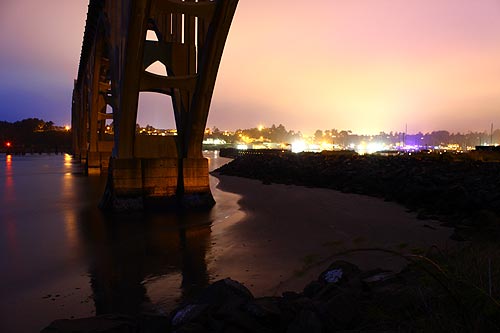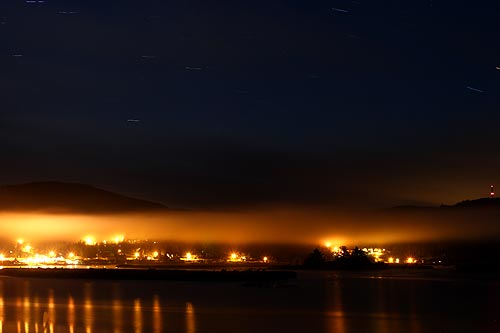 |
Astronomy Lessons the Oregon Coast Teaches You
Published 10/20/2011

(Oregon Coast) – It doesn't happen all the time, by any means. But when the skies clear up at night on the Oregon coast, it's a lot clearer than the skies inland, even with the mists of the ocean floating around. The end results are some startling sights to be spotted in the skies, as the pristine conditions allow some insane interstellar viewing.
It's amazing the kind of astronomy lessons these places can impart, aside from the pure awe of this kind of beauty that practically smacks you in the head if you only look upwards at night.
A favorite for these moments is above Manzanita, at the Neahkahnie overlooks, where by day the ocean vistas are constantly startling. At night, however, it's a lot easier to spot galactic phenomena, and shooting stars are practically commonplace at times.
In early May of 2011, this shot was taken from the north coast landmark, showing the usual (yet always stunning) movement of the stars that happens when you use long exposures to capture low light scenes like this.
Puzzling, however, is the orange-tinted, slightly brighter star near the top. Jim Todd, planetarium manager at OMSI in Portland, answered the questions about this.
“The bright orange object is actually the star Arcturus of Bootes, now visible above the southern horizon,” Todd said back in May.

Just up the road, at Cannon Beach, one summer night at Ecola State Park yielded this arresting vista of the universe. The Milky Way is fairly clearly visible hovering over the tiny north Oregon coast town.

Also in the Cannon Beach area, another summer night produced this surreal image at the southern end of town, just south of the Tolovana area. If you take enough night photos of the coast, you start to notice minute sources of light can paint the clouds from below with surprising influence, like this distant fishing boat.
A break in these clouds allows the star streaks to come through in an awe-inspiring twist to this photographic expedition.

Other things you learn at night on the beaches are the ways certain light sources change what you see, along with various gasses. It turns out, according to OMSI's Todd, the camera can see a variety of colors and gasses the human eye can not see. Like above, at Newport, where fog has infiltrated the Yaquina Bay, and various kinds of lights bounce and bend in the air, changing colors. Various gasses in the air also can alter the shadings.
This is a bit more visible when looking at star photos in the sky: you'll notice some stars are different colors than others. These are atmospheric gasses being picked up by the camera and changing the shades in ways your eye can't see.

Sometimes weather phenomena can make for some really unexpected effects. Here, at Wheeler, on the Nehalem Bay, meteorology combines with astronomy to create something really new. From a distance, you can see a low-lying fog hovering over Wheeler, which makes for its own visual stunners, causing light to bounce around in there in captivating ways. But from here you can also see the night sky above it all – a sea of stars above this town near the ocean.

At Astoria, clouds and the creations of Man make for enthralling effects as well, even the kind that fool you just a tad. There's an odd green haze in the air in the middle of the photo – which starts to look like the Aurora Borealis, the northern lights. But alas, it is not. This again is an example how the lights of even a mere ship can alter the landscape. It is a massive ship, to be sure, but its greenish lights are what is painting the haze and clouds in the skies above it, making it look like the famed electromagnetic display.

Since the subject here is more or less astronomy, there's a hefty helping an extraterrestrial experience to be had while bouncing around the beaches at night. If you want the feel of visiting another planet, check out the beach after dark. Like here, at Newport's Nye Beach, a variety of light sources and the misty look of the blurred ocean (from the long exposure) makes this Oregon coast landmark look much more like another planet than our own Earth. It's surreal, startling and gorgeous at the same time.
Other awesome spots for interstellar viewing on the coast are Cape Foulweather or Rodea Point near Depoe Bay, much of the Yachats area, or any dark beach and / or vantage point with little light interference.
More About Oregon Coast hotels, lodging.....
More About Oregon Coast Restaurants, Dining.....
 |
LATEST OREGON COAST NEWS STORIES
Decay Hits Beloved Oregon Coast Tree, Now the Newport Icon Must Be Cut Down |
Back to Oregon Coast
Contact Advertise on BeachConnection.net
Secrets of the Season |
Unusual Travel Articles TravelParanormal.com allows you to submit your own creepy tale or debunk one - or see up-to-the-minute news headlines about travel and the paranormal. News Headlines from All Over Oregon Need to scan Oregon headlines? Constantly updated news from all over Oregon: a comprehensive, up-to-the-minute display of news headlines from a variety of media |






































